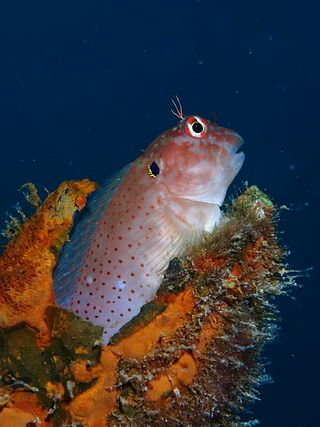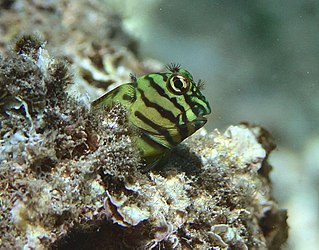
Salarias fasciatus, commonly known as the jewelled blenny or lawnmower blenny is a benthic, neritic, marine fish species endemic to Australasia. Despite being known as the lawnmower blenny, due to its propensity to consume algae growth in aquaria, it is principally a detritivore, with plant material making up only about 15% of its diet. The lawnmower blenny camoflauges itself with its surroundings, even changing color to hide from predators.

Cirripectes is a large genus of combtooth blennies found throughout the Pacific and Indian oceans. Cirripectes biconvexus, an otolith based fossil species from the Burdigalian (Miocene) of southwestern India is probably the earliest record of this genus.

Cirripectes alboapicalis is a species of combtooth blenny found in coral reefs in the Pacific ocean. This species reaches a maximum length of 15.5 centimetres (6.1 in).
Cirripectes alleni, the Kimberley blenny, is a species of combtooth blenny found in coral reefs in the eastern Indian Ocean, around Australia. These species reaches a length of 6.5 centimetres (2.6 in) TL. The specific name honours the ichthyologist Gerald R. Allen.

Cirripectes auritus, the blackflap blenny, is a species of combtooth blenny found in coral reefs in the Indo-West Pacific region.

Cirripectes castaneus, the chestnut eyelash-blenny, is a species of combtooth blenny found in coral reefs in the western Pacific and Indian oceans. This species reaches a length of 12.5 centimetres (4.9 in) TL.
Cirripectes chelomatus, the Lady Musgrave blenny, is a species of combtooth blenny found in coral reefs in the western Pacific ocean. This species reaches a length of 12 centimetres (4.7 in) TL.
Cirripectes fuscoguttatus, the spotted blenny, is a species of combtooth blenny found in coral reefs in the Pacific ocean. This species reaches a length of 15 centimetres (5.9 in) TL.
Cirripectes imitator, the imitator blenny, is a species of combtooth blenny found in coral reefs in the western Pacific ocean. This species reaches a length of 12 centimetres (4.7 in) TL.
Cirripectes perustus, the flaming blenny, is a species of combtooth blenny found in coral reefs in the Pacific and Indian oceans. This species reaches a length of 12 centimetres (4.7 in) TL.

Cirripectes polyzona, the barred blenny, is a species of combtooth blenny found in coral reefs in the Indo-West pacific region. This species reaches a length of 13 centimetres (5.1 in) TL.
Cirripectes quagga, also known as the squiggly blenny or zebra blenny, is a species of combtooth blenny found in coral reefs in the Pacific and Indian oceans. This species reaches a length of 10 centimetres (3.9 in) TL.
Cirripectes springeri, Springer's blenny or the spotted eyelash blenny, is a species of combtooth blenny found in coral reefs in the western Pacific Ocean. This species reaches a length of 10 centimetres (3.9 in) TL. The specific name honours the American ichthyologist Victor G. Springer of the United States National Museum who has worked extensively on blennies.

Cirripectes vanderbilti, also known as the scarface blenny, is a species of combtooth blenny found in coral reefs in the Hawaiian and Johnston Atoll in the eastern central Pacific ocean. This species reaches a length of 10 cm (3.9 in) SL. It is commonly confused with Cirripectes variolosus.
Cirripectes variolosus, the red-speckled blenny, is a species of combtooth blenny found in coral reefs in the Pacific Ocean. This species reaches a length of 10 centimetres (3.9 in) TL.
Cirripectes viriosus, the robust blenny, is a species of combtooth blenny found in the western central Pacific ocean, around the Batan Islands and the Philippines. This species reaches a length of 11.5 centimetres (4.5 in) SL.
Plagiotremus ewaensis, the Ewa blenny, Ewa fangblenny or the blue-stripe blenny, is a reef fish belonging to the Blenniidae family. This species of combtooth blenny can be found in coral reefs and is an endemic species to the Hawaiian Islands.

The Hawaiian blackhead triplefin, also known as the Hawaiian triplefin in Hawaii, is a species of triplefin blenny in the genus Enneapterygius. It is a tropical blenny found in coral reefs in the Pacific Ocean, from the Hawaiian Islands, French Frigate Shoals, Laysan Island, and Midway Atoll. Blennies in this species swim at a depth range of 1–23 metres, and inhabit dead coral and rock.

Cirripectes matatakaro, the Suspiria blenny, is a species of combtooth blenny that occurs on coral reefs in the central/southern tropical Pacific. In the northern hemisphere, it is known from the Northern Line Islands and in the southern hemisphere it occurs at the Marquesas, Tuamotu, Pitcairn, Gambier, and Austral islands. This species reaches a length of 6.5 centimetres (2.6 in) SL.

Entomacrodus marmoratus, also called the marbled blenny or pāo'o in Hawaiian, is a species of blenny endemic to the rocky reefs around the coasts of Hawaii. It has fins that are used to jump out of the water and to navigate the tide pools.









